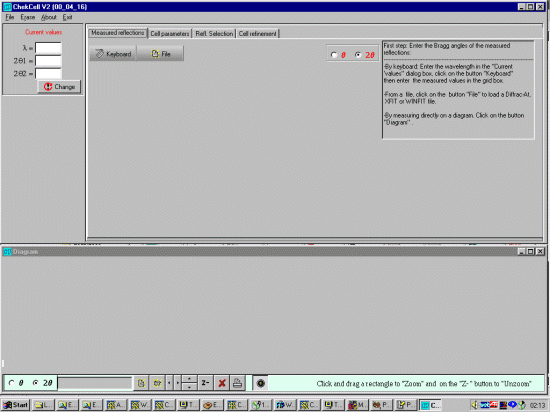
CHEKCELL: Graphical Powder Indexing helper and Spacegroup Assignment Software that links into the Crysfire Powder Indexing Suite by Robin Shirley
CHEKCELL now has a version of Truecell included with it under the "Cell Parameters" window. For tutorial runthroughs of Truecell in stand-alone mode, refer to the LMGP Suite Main Page
CHEKCELL can be obtained off the web at the the LMGP
(Laboratoire des Materiaux et du Génie Physique de l'Ecole Supérieure de
Physique de Grenoble http://www.inpg.fr/LMGP/)
program suite site at:
Sunday, 3rd December 2000: Bleeding Edge beta test versions of LMGP suite software such as Chekcell, Gretep and new programs are now available in the bleeding_edge_beta_versions/ subdirectory off the above download web addresses (wait 24 hours for the Canadian and Australian server to update). Please E-mail Lachlan Cranswick (l.m.d.cranswick@dl.ac.uk) with any bugs of Bleeding edge versions of the LMGP suite who will collate them and send them to the authors.
|
| NOTE: If Chekcell fails to give any suggested cells, or only seems to be analysing a very small subset of the trial cells, make sure to check the options of the Best Solution Search window as you may have default limits from a previous session that are not applicable to the present problem (i.e., number of indexed peaks, too high a figure of merit or too strick limits on maximum cell size, etc) |
|
The example data file is of poor quality data of a minor phase in halite. The unknown peaks were run through the
Crysfire Powder Indexing Suite by Robin Shirley. Crysfire can be run concurrently with Chekcell but this assumes you already have some trial cells from Crysfire in the Crysfire *.SUM summary file. In this demonstration, we will be demonstrating the ability of Chekcell to automatically dredge through the trial cells to select a possible "best" set of cell/spacegroup combinations for the user to evaluate. It is possible for the user to concurrently run Crysfire and import the updated *.SUM Summary file at the click of a button. |
|
Click on the CHEKCELL icon or run the program via the windows explorer/windows file manager to
bring up the CHEKCELL starting interface.

|
|
You can then open a Powder diffraction data file using either the
File, Open, Profile menu option or the the bottom left
hand set of ICONs (Chekcell can presently use Siemens/Bruker RAW, CPI or RIET7 DAT
raw datafiles). In this case we open a liti.dat file. Chekcell will prompt for
the Wavelength of the peak file. Select Other and type in the wavelength: 1.54056
Angstrom (Cu k Alpha 1)
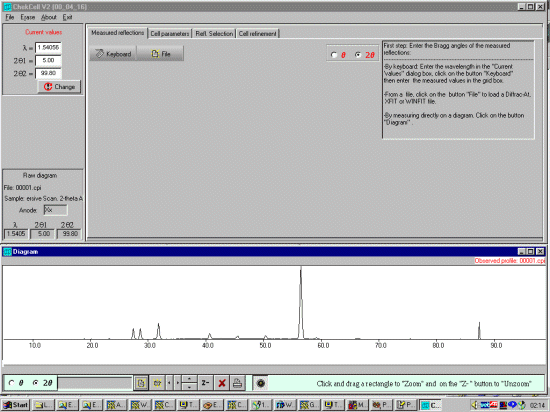
|
|
pen a peak find/peak profile file either via the File, Open, Peaks File or
the ICON under the Measured Reflections tab.
The peaks will be displayed on the bottom window. (Celref can presently import Siemens/Bruker DIF,
Winfit *.DAT, or XFIT *.TXT peak find/peak profile output files). If loading an XFIT or related file
(in this case a liti.txt XFIT peak profile file),
when prompted for wavelength select OTHER and confirm the
wavelength being used (1.54056 Angstrom) and continue.
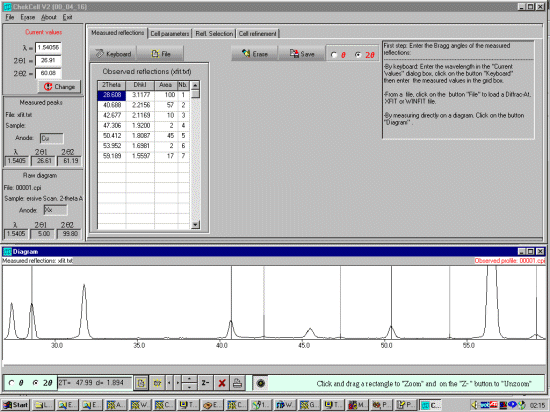
You will note that not all the peaks are assigned as the other peaks are due to halite. |
|
Select the Cell Parameters tab and select the CRYSFIRE button bringing
up file open prompt to find the Crysfire *.SUM file.
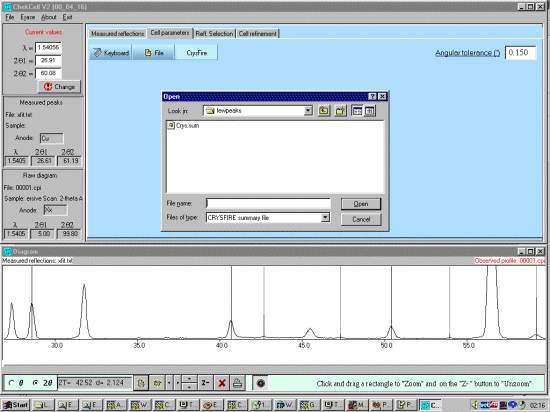
Select the relevant Crysfire *.SUM file which will display the Cells summarised by Crysfire, and display the peaks expected from the first cell in the Crysfire file at the lowest symmetry spacegroup.
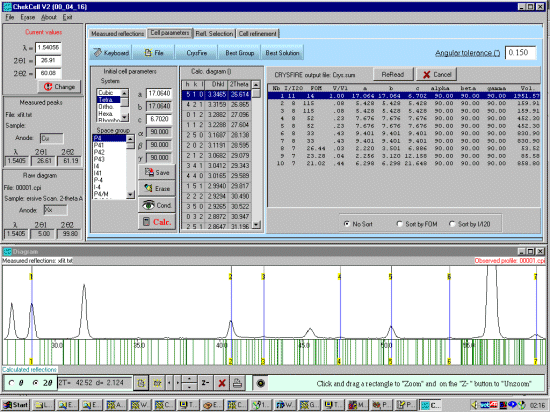
|
|
While it may be obvious what the correct cell is from here, for
the porposes on this demonstration, select Best Solution
to be given the following interface.
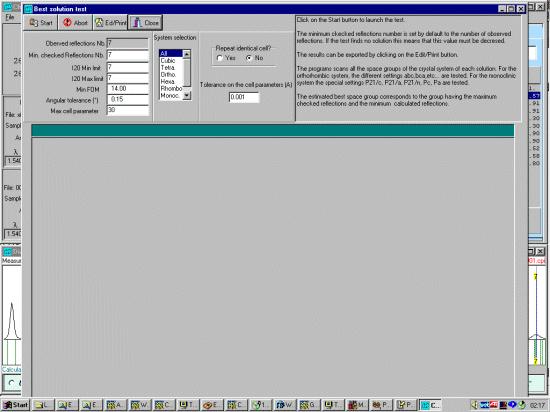
|
|
Now select the tolerances for peforming a Cell and Spacegroup search
noting that the previous sample may have perturned the defaults.
In this case, some strange things have happened and some of the indexing programs have claimed to have indexed on 8 and 11 peaks, despite the fact that only 7 peaks were submitted for indexing. However, Checkcell knows that the various powder indexing programs can do weird things. Thus it has set I20 Min and I20 Max to 7 (the number of peaks in the XFIT.TXT file). Also, (for the sake of speed), limit the cell axes that will be considered to 15 Angstrom. Though you can always revisit the larger cells later. (If you expect impurity peaks, decrease the Min Checked Reflection No.)
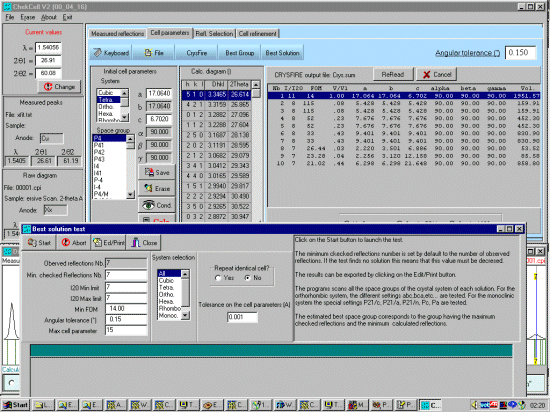
|
|
Now select Start for ChekCell to
automatically sort the spacegroups in order of most likelyhood. (including non standard settings).
(Please be patient and wait for chekcell to finish as it summarises the best
cells/spacegroups at the end of the number crunching).
You also view the results in Wordpad and cut and paste into other applications.
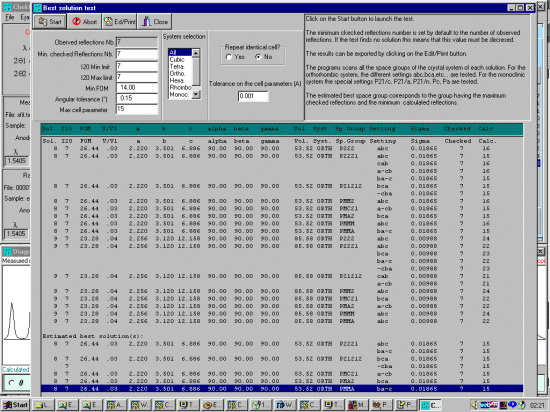
In this case it suggests an orthorhombic cell with a variety of settings. Though as per normal, and especially with so few peaks, this is the time to be very careful in looking at the various results. Though the suggested cell does look quite nice.
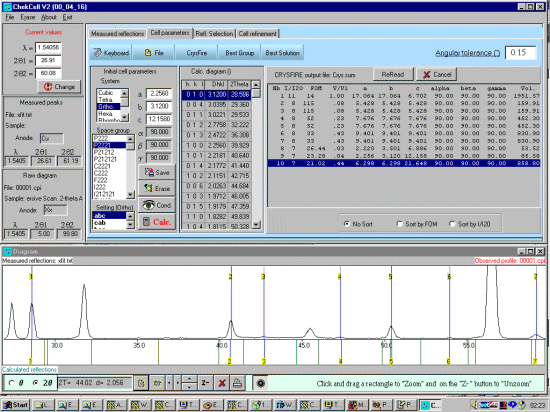
You can also graphically evaluate other spacegroups at Whim of course. |
Orthorhombic vs Cubic cells.The following relates to the above other cells found by the various indexing systems.Note from Jean Laugier of 11th April 2000From: "Jean Laugier" [jean.laugier2@wanadoo.fr] To: "Lachlan Cranswick" [l.m.d.cranswick@dl.ac.uk] Subject: Error in Chekcell and Celref Date: Tue, 11 Apr 2000 17:53:32 +0200 I found a serious error in Chekcell and Celref. The Miller indices generator forgot lines when too close to another.This can be seen with the attached example (unix.sum and unix.txt). So the best determinated group can be different. This situation was verified for the orthorhombic solution (a=3.746 b=5.297 c=7.487) several lines are in fact groups of lines. This is a particular situation because in my opinion the best systeme is cubic (a*2*sqrt(2)~b*2~c*sqrt(2)~10.59) These relations are the best proof that this structure is cubic. |